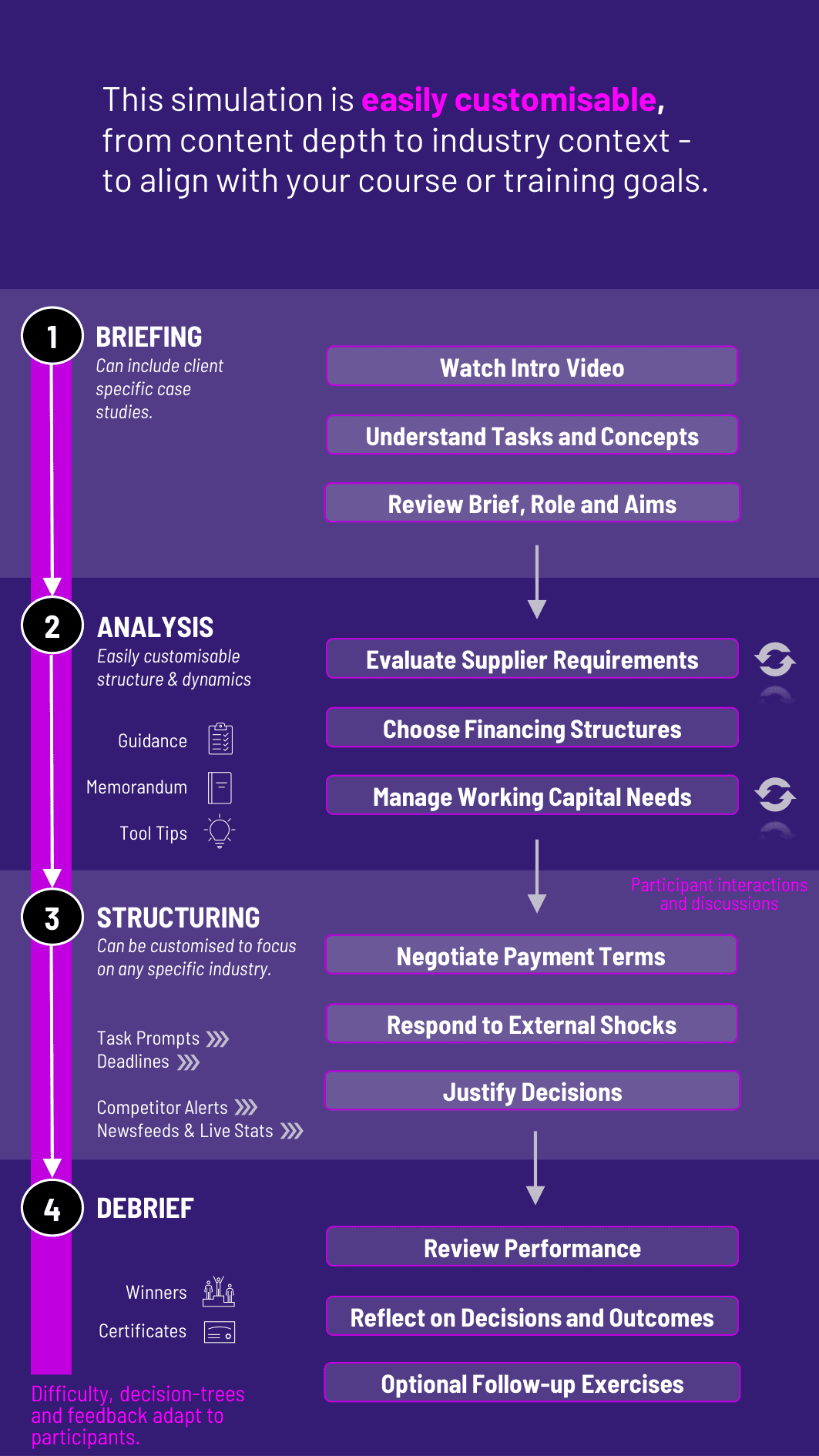
Students manage supplier relationships, working capital, and financing decisions across global trade networks in our Supply Chain Finance Simulation.
Working Capital Management: Managing payables, receivables, and inventory
Trade Credit Terms: Net terms, early payment discounts, and deferred payment structures
Supply Chain Financing Tools: Reverse factoring, dynamic discounting, and supplier financing
Cost of Capital and Liquidity: Evaluating trade-offs between cash preservation and supplier support
Supplier Risk Assessment: Creditworthiness, concentration, and geographic exposure
Bank and Fintech Partnerships: Structuring third-party solutions
ESG and Resilience Considerations: Balancing cost, ethics, and supplier health


Evaluate supplier needs, liquidity positions, and strategic importance
Negotiate payment terms and financing arrangements with suppliers and banks
Choose between self-funded or third-party financing structures
Respond to external shocks (e.g. raw material shortages, currency devaluation, or supplier insolvency)
Optimize working capital while maintaining supplier health and relationships
Justify decisions in board memos or supplier review meetings
This simulation teaches students how finance and operations decisions interconnect. Students learn to:
Manage liquidity not just internally, but across the entire supply chain
Structure financing arrangements that support both buyer and supplier
Weigh cost of capital against supplier reliability and continuity
Apply ethical and strategic thinking to supplier relationships
Collaborate across functions to align procurement, treasury, and strategy
Communicate trade-offs and results clearly to financial and operational stakeholders
Do students need background knowledge in supply chain or finance? No prior specialization is needed. A basic understanding of working capital and supplier dynamics is helpful, and all key concepts are introduced in the simulation.
What types of suppliers are included? The simulation includes domestic and international suppliers with varied financial health, strategic importance, and pricing power.
Does the simulation include ESG or sustainability considerations? Yes. Students must consider how their financing and negotiation decisions impact supplier resilience, local communities, and sustainability commitments.
Are students exposed to multiple financing instruments? Yes. The simulation includes reverse factoring, dynamic discounting, bank credit lines, and self-funded early payment models.
Is this simulation team-based or individual? Both formats are available. Team-based play allows students to divide roles (e.g. procurement lead, treasury officer, finance analyst) and negotiate strategies together.
Can this be customized for specific industries (e.g. retail, manufacturing)? Yes. Instructors can choose industry-specific supplier chains with relevant cash cycles, pricing terms, and operational challenges.
How long does the simulation take? 5 to 6 hours for a standard session. Longer formats can be used to simulate full-quarter decision cycles and long-term supplier outcomes.
How is student performance measured? Based on working capital optimization, supplier retention, cost of capital, and the quality of rationale in stakeholder reports or presentations.
Does it involve negotiation or communication tasks? Yes. Students must justify payment terms and financing choices in memos, supplier calls, or stakeholder updates—building soft skills alongside technical ones.
Can it be integrated into finance, operations, or ESG-focused courses? Absolutely. The simulation is cross-functional by design and works well in corporate finance, supply chain strategy, and sustainable business programs.
Join this 20-minute webinar, followed by a Q&A session, to immerse yourself in the simulation.
or
Book a 15-minute Zoom demo with one of our experts to explore how the simulation can benefit you.